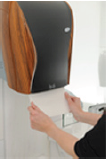A Standard Operating Procedure (SOP) is a set of written instructions that document a routine activity that is to be followed by members of an organization. Standard Operating Procedures are essential parts of good quality systems. Sound and well-written SOPs should enhance consistency and reduce human error. Note: sometimes standard operating procedures are referred to as Work Instructions.
Example: An example of what is becoming a common standard operating procedure can be seen in almost any food service organization or hospital: washing hands. Most of the hand-washing SOPs contain some version of the following.
Inadequate SOP:
1. Wet hands and forearms.
2. Thoroughly apply the soap.
3. Lather the hands and forearms.
4. Continue to lather and scrub.
5. Thoroughly rinse forearms and hands.
6. Dry hands and forearms thoroughly.
This SOP lacks detail.
Better:
1. Wet hands and forearms with warm, running water (the water temperature should reach at least 100 ºF)
2. Thoroughly apply the soap from the forearms to the hands.
3. Lather the hands and forearms. Be sure to get soap under fingernails and between fingers.
4. Continue to lather and scrub for at least 10 seconds.
5. Thoroughly rinse forearms and hands with clean water. No remaining soap should be visible on the forearms, hands, or under nails.
6. Dry hands and forearms thoroughly with single-use paper towels.
7. Use the paper towel to turn off the water and use the same paper towel to open the door as you exit the restroom.
This is a better SOP because it provides more specificity.
Best:
1. Wet hands and forearms with warm, running water (the water temperature should reach at least 100 ºF)
2. Thoroughly apply the soap to the hands.
3. Lather the hands and forearms. Be sure to get soap under fingernails and between fingers.
4. Continue to lather and scrub for at least 10 seconds.
5. Thoroughly rinse forearms and hands with clean water. No remaining soap should be visible on the forearms, hands, between finders, or under nails.
6. Dry hands and forearms thoroughly with single-use paper towel.
7. Use the paper towel to turn off the water and use the same paper towel to open the door as you exit the restroom. If there is no waste basket in the washing area, carry the paper towel to a place that has one, as long as you do not have to touch anything between the washing room and the process.
Providing pictures or illustrations take away some of the ambiguity.
SOP Effectiveness:
Creating a work instruction is only the beginning. What good is an SOP if it isn’t being followed? It is recommended that periodic audits are conducted to ensure that the SOPs are being followed fully and consistently over time.

